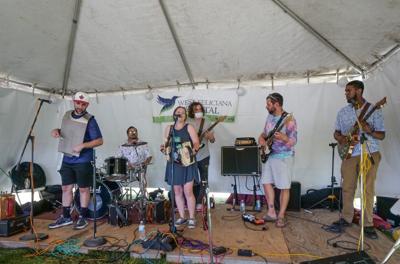In Lafayette, you can eat a Cajun Samurai pizza after cheering on the Louisiana Ragin’ Cajuns football team to victory at Cajun Field, next to the Cajundome. Opelousas recently hosted the Holy Ghost Creole Festival, two miles from the Creole Heritage Folklife Center and two hours from the Creole Heritage Center in Natchitoches.
Cajun and Creole people have been celebrated for cuisine, music, language, art, architecture and lifestyles that have locals thanking God we’re not Mississippi. Yet both terms have sparked generations of misunderstanding and discrimination that still result in virtual fistfights and friend-blocking on social media.
Kelly Crouch, a New Orleans native living in Bozeman, Utah, wonders what’s the difference between Cajuns and Creoles. The answer depends on the time period, geography and who’s telling the story.
These days, it’s common for White people to be called Cajuns, and Black and mixed-race people, Creoles. Mass media and marketing have slapped Cajun labels on almost anyone from Louisiana or food overloaded with salt and pepper.
But such usage can be a mistake and a disregard for the complex history and nuances of both ethnicities.
Cajuns are descendants of Acadians, exiles from Nova Scotia who settled in south Louisiana in the mid-1700s. As historian Shane Bernard points out in his 2003 book, “The Cajuns: Americanization of a People,” this group of roughly 3,000 Acadians intermarried with French, Spanish and Germans settlers, along with Anglo-Americans and Native Americans.
“They were also influenced by Afro-Caribbean slaves and their descendants, who, like the Cajuns, shared a French-Catholic heritage. This cross-cultural pollination transformed the region’s white ethnic groups into a single new ethnic group, the Cajuns ...”
But Cajun evolved into a bad word as these French-speaking immigrants encountered Americans in the 18th and early 19th centuries. Bernard cites journalists describing Cajuns as “lazy vagabonds,” “ignorant and wretched” and “good representatives of the white trash.”
French was later banned in public schools with students spanked for speaking the language. Cajun musicians invited to perform at the 1965 Newport Folk Festival were mocked in a blistering, Opelousas Daily World editorial titled “They Call That Music??!!”
Ironically, the musicians were met with standing ovations. That applause followed them home and helped spark a music, language and cultural renaissance through the 1970s and ‘80s.
Creole culture became a footnote in this rebirth, even though Creoles preceded Cajuns in Louisiana and have existed across the globe. Historians trace the word’s origin to the Portuguese crioulo, a reference to anything or any person born in the New World.
The term has been used, for centuries — in Africa, the Caribbean and across North, Central and South America.
In her 2018 book, “Creoles of South Louisiana: Three Centuries Strong,” Elista Istre, Ph.D., places Creoles in three distinct areas — near Natchitoches along the Cane River; in the prairies and swamps of the southwest region called Acadiana; and New Orleans. Istre details classes of affluent White Creoles of planter aristocracy, enslaved Black Creoles and free people or Creoles of color.
Istre writes “With so much confusion surrounding usage of the term ‘Creole,’ even among scholars, it is not surprising that many people bring their own idea of ‘créolité’ or ‘creolism’ to the table. … The reality is all of these definitions are correct.”
Christophe Landry, Ph.D., a New Iberia native and research team manager at Ancestry, calls Creoles and Cajuns “cousins” who shared the same land, genealogy and cultural identity for more than 200 years.
“In the 20th century, that shifted to Cajun for White only and Creole for everyone else,” said Landry.
“I get follow-up questions, dealing with gumbo with tomatoes and all this nonsense people fight about online. All of that stuff is just a distraction. It’s still gumbo. People are really trying to find some fundamental difference between Cajun and Creole because of the fact it’s the same. Period.”
Ashlee Michot, 41, represents young natives embracing this more inclusive perspective. Growing up in Ville Platte in Evangeline Parish, Michot remembers many old people simply describing themselves as “French.”
Michot said technology and a variety of research have shaped a more personal identity.
“I do accept that I’m a Cajun and I live part in the Cajun culture of Louisiana,” said Michot, a writer and French radio announcer. “I have Acadian ancestry on both sides of my family.
“But I also have Creole, Spanish and all other kinds of ancestry. Because of my access to genealogy, I’ve been able to understand myself more and not just listen to what X, Y or Z says.”

